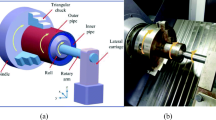Abstract
Tube spinning technology represents a process with high forming precision and good flexibility and is increasingly being used in the manufacture of bimetal composite tubular structures. In the present study, a forming analysis of clad tube and base tube in spinning process was conducted through numerical simulations and experiments. There was an equivalent stress transition on the interface since the stress transmission was retarded from clad tube to base tube. The yield strength became a main consideration during a design bimetal composite tube. Meanwhile, the strain distributions in axial direction, tangential direction, and radial direction were also investigated to determine the deformation characteristics of each component. As the press amount increased, the strain of clad tube changed more than base tube. As the feed rate increased, the strain decreased in axial direction and tangential direction but almost unchanged in radial direction. Simultaneously, a method for controlling the wall thickness of the clad tube and the base tube is proposed. These results to guide the design of bimetal tube composite spinning process have the certain meanings.
Similar content being viewed by others
References
Wang H, Han J, Hui Z (2013) The basic research on numerical simulation of bimetal composited T-tube through hydraulic bulging. Appl Mech Mater 278-280:487–490
Khosravifard A, Ebrahimi R (2010) Investigation of parameters affecting interface strength in Al/Cu clad bimetal rod extrusion process. Mater Des 31(1):493–499
Shaparev AV, Savin I (2016) Calculation of the amount of the reduction required for the formation of compound layers during cold rolling of bimetals. Mater Sci Forum 870:328–333
Halaczek D (2016) Analysis of manufacturing bimetallic tubes by the cold drawing process. Arch Metall Mater 61(1):241–248
Guo X et al (2013) Effects of the inner mould material on the aluminium–316L stainless steel explosive clad pipe. Mater Des 49:116–122
Sponseller DL, Timmons GA, Bakker WT (1998) Development of clad boiler tubes extruded from bimetallic centrifugal castings. J Mater Eng Perform 7(2):227–238
Yu H, Fan Z, Li C (2014) Magnetic pulse cladding of aluminum alloy on mild steel tube. J Mater Process Technol 214(2):141–150
Xia Q, Xiao G, Long H et al (2014) A review of process advancement of novel metal spinning. Int J Mach Tool Manu 85(7):100–121
Mohebbi MS, Akbarzadeh A (2010) A novel spin-bonding process for manufacturing multilayered clad tubes. J Mater Process Technol 210(3):510–517
Mohebbi MS, Akbarzadeh A (2010) Accumulative spin-bonding (ASB) as a novel SPD process for fabrication of nanostructured tubes. Mater Sci Eng A 528(1):180–188
Mohebbi MS, Akbarzadeh A (2011) Fabrication of copper/aluminum composite tubes by spin-bonding process: experiments and modeling. Int J Adv Manuf Technol 54(9–12):1043–1055
Jiang S, Zhang Y, Zhao Y, et al. (2016) Investigation of interface compatibility during ball spinning of composite tube of copper and aluminum. Int J Adv Manuf Technol:1–8
Zhang Z, Xu W, Shan D (2014) An analytical model on spin-bonding of composite tube. Procedia Eng 81:2024–2029
Xu W et al (2017) Effect of heat treatment and initial thickness ratio on spin bonding of 3A21/5A03 composite tube. J Mater Process Technol 247:143–157
Zhang Z et al (2018) Fabrication of steel/aluminum clad tube by spin bonding and annealing treatment. Int J Adv Manuf Technol 94(9–12):3605–3617
Bonet J, Kulasegaram S (2000) Correction and stabilization of smooth particle hydrodynamics methods with applications in metal forming simulations. Int J Numer Methods Eng 47(6):1189–1214
Zoghi H, Arezoodar AF, Sayeaftabi M (2013) Enhanced finite element analysis of material deformation and strain distribution in spinning of 42CrMo steel tubes at elevated temperature. Mater Des 47(9):234–242
Thamburaja P, Ekambaram R (2007) Coupled thermo-mechanical modelling of bulk-metallic glasses: theory, finite-element simulations and experimental verification. J MECH PHYS SOLIDS 55(6):1236–1273
Sonmez FO, Demir A (2007) Analytical relations between hardness and strain for cold formed parts. J Mater Process Technol 186(1):163–173
Bay N, Clemensen C, Juelstorp O, et al(1985) Bond strength in cold roll bonding[J]. CIRP ANN-MANUF TECHN 34(1):221–224
Jia Z, Han ZR, Xu Q et al (2015) Effects of processing parameters on the surface quality of square section die-less spinning. Int J Adv Manuf Technol 80(9–12):1689–1700
Funding
This work was supported by the Natural Science Foundation of Jiangsu Province (No. BK20170788).
Author information
Authors and Affiliations
Corresponding author
Rights and permissions
About this article
Cite this article
Jin, K., Yuan, Q., Tao, J. et al. Analysis of the forming characteristics for Cu/Al bimetal tubes produced by the spinning process. Int J Adv Manuf Technol 101, 147–155 (2019). https://doi.org/10.1007/s00170-018-2836-6
Received:
Accepted:
Published:
Issue Date:
DOI: https://doi.org/10.1007/s00170-018-2836-6




